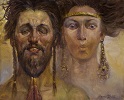


|

|

|
"Portrait of Dr. Henryk Boreniok", 1937, pastel on paper, 70 x 50 cm, Silesian Museum, Katowice
"Portrait of a Girl", 1937 30/31/III, pastel on paper, 63.4 x 47.4 cm, private collection
"Portrait of Maria Suchon", 1930 23/IV, pastel on paper, 61.5 x 45.5 cm, private collection

|

|

|
"Portrait of a Man", 1917, pastel, charcoal on paper, 64.8 x 49.3 cm, private collection
"Portrait of Jadwiga Sobolewska", VII 1936, pastel on paper, 69.3 x 49.5 cm, private collection
"Napoleon's Grenadier", 25 VIII 1929, pastel on paper, 63 x 48.5 cm, private collection

|

|

|
"Portrait of Irena Wiedyskiewicz-Polniakowa", 1925 12/XI, pastel on paper, 63.5 x 47.8 cm, private collection
"Self-Portrait", 1938 29/30 IV, pastel on paper, 68.5 x 48.5 cm, National Museum, Warsaw
"Dr. Jeckyll (Self-Portrait)", 1938, pastel on paper, 64.5 x 48 cm, National Museum, Warsaw
[..] the Formist group whose members adapted certain features of Futurism, Cubism and Expresionism. The Formist movement was rather short-lived (1917-1922) but it had two excellent protagonists. One was Leon Chwistek [..] The second was Stanislaw Ignacy Witkiewicz - Witkacy, the most extraordinary individuality of artistic and intellectual life in inter-war Poland, painter, theoretician of art, writer, and dramatist. As the son of Stanislaw Witkiewicz, the creator of the vernacular "Zakopane style", he grew up in artistic household and the stimulating Young Poland atmosphere of Zakopane. In 1914, he left, together with the celebrated anthropologist Bronislaw Malinowski, for an exotic trip to Ceylon and Australia, and then spent the October Revolution in Russia. Paintings originating from the period after his return to Poland in 1918 are airless, multi-strata compositions and perverse phantasmagoria, in which threatening monsters with animal shapes wrestle in incomprehensible strife. The forms are flat and angular, and the colour is composed of loud dissonances. In 1919, the artist proclaimed his theory of "Pure Form", the first Polish philosophically grounded theory of art. In the mid-1920s, Witkacy recognised "artistic work" to be barren, and established a one-person openly commercial Portrait Firm, which produced differently priced pastels "made to order" in accordance with the wishes of the client - "smooth" portraits as well as deformed, vibrating images executed under the impact of narcotics.
[*]
Artist’s paintings in malarze.com
Click this link to read Witkacy's biography at Culture.pl
Artist biography at Wikipedia: http://en.wikipedia.org/wiki/Stanisław_Ignacy_Witkiewicz
| STORE |
     ARTWORKS of CONTEMPORARY POLISH ARTISTS for SALE |